Geochemical Characteristics and Hydrocarbon Generation Potential of Coal-Measure Source Rocks in Julu Sag
Abstract
:1. Introduction
2. Geological Settings
3. Organic Geochemical Characteristics of Source Rocks
3.1. Samples and Experimental Method
3.2. Coal Seam
3.3. Mud Shale
4. Accumulation Process of Coal-Measure Gas
4.1. 1D Basin Modeling Method and Parameters
4.2. Numerical Simulation of the Hydrocarbon Generation Process
4.3. Analysis of the Accumulation Process
5. Conclusions
Author Contributions
Funding
Data Availability Statement
Acknowledgments
Conflicts of Interest
References
- Xie, W.D.; Wang, M.; Hou, X.W. Study on enrichment zones and enrichment regularity of coalbed methane in Hebei province. J. Henan Polytech. Univ. Nat. Sci. 2018, 37, 17–25. (In Chinese) [Google Scholar]
- Jiang, T.; Liu, Z.Y.; Wang, T.; Song, H.Z. Discussion on Upper Paleozoic Coal Measures Gas Reservoiring Mechanism in Northeastern Ordos Basin. Coal. Geol. China 2015, 27, 43–47. (In Chinese) [Google Scholar]
- Cao, D.Y.; Yao, Z.; Li, J. Evaluation Status and Development Trend of Unconventional Gas in Coal Measure. Coal Sci. Technol. 2014, 42, 89–92. (In Chinese) [Google Scholar]
- Zhu, Y.M.; Hou, X.W.; Cui, Z.B.; Liu, G. Resources and reservoir formation of unconventional gas in coal measure, Hebei Province. J. China Coal Soc. 2016, 41, 202–211. [Google Scholar]
- Cao, Y.T.; Liu, L.; Chen, D.L.; Wang, C.; Yang, W.Q.; Kang, L.; Zhu, X.H. Partial melting during exhumation of Paleozoic ret–rograde eclogite in North Qaidam, western China. J. Asian Earth Sci. 2017, 148, 223–240. [Google Scholar] [CrossRef]
- Feng, Z.J.; Dong, D.Z.; Tian, J.Q.; Qiu, Z.; Wu, W.; Zhang, C. Geochemical characteristics of longmaxi formation shale gas in the weiyuan area, Sichuan Basin, China. J. Petrol. Sci. Eng. 2018, 167, 538–548. [Google Scholar] [CrossRef]
- Wang, Z.; Zhao, J.Z.; Chen, Y.H. Analysis of palaeo–sedimentary environment and characteristics of Shanxi formation in Shenfu area on the eastern margin of Ordos basin. J. Xi’an Shiyou Univ. Nat. Sci. Ed. 2019, 34, 24–30. (In Chinese) [Google Scholar]
- Sang, S.X.; Han, S.J.; Liu, S.Q.; Zhou, X.Z.; Li, M.X.; Hu, Q.J.; Zhang, C. Comprehensive study on the enrichment mechanism of coal bed methane in high rank coal reservoirs. J. China Coal Soc. 2022, 47, 388–403. (In Chinese) [Google Scholar]
- Gao, J.; Li, X.S.; Cheng, G.X.; Luo, H.; Zhu, H.J. Structural evolution and char-acterization of organic-rich shale from macroscopic to microscopic resolution: The significance of tectonic activity. Adv. Geo-Energy Res. 2023, 10, 84–90. [Google Scholar] [CrossRef]
- Zhu, H.J.; Huang, C.; Ju, Y.W.; Bu, H.L.; Li, X.S.; Yang, M.P.; Chu, Q.Z.; Feng, H.Y.; Qiao, P.; Qi, Y.; et al. Multi-scale multi-dimensional characterization of clay-hosted pore networks of shale using FIBSEM, TEM, and X-ray micro-tomography: Implications for methane storage and migration. Appl. Clay Sci. 2021, 213, 106239. [Google Scholar] [CrossRef]
- Cao, D.Y.; Liu, K.; Liu, J.C.; Xu, H.; Li, J.; Qin, G.H. Combination characteristics of unconventional gas in coal measure in the west margin of Ordos Basin. J. China Coal Soc. 2016, 41, 277–285. (In Chinese) [Google Scholar]
- Qin, Y.; Shen, J.; Shen, Y.L. Joint mining compatibility of superposed gas–bearing systems: A general geological problem for extraction of three natural gases and deep CBM in coal series. J. China Coal Soc. 2016, 41, 14–23. (In Chinese) [Google Scholar]
- Liang, B.; Shi, Y.S.; Sun, W.J.; Liu, Q. Reservoir forming characteristics of “the three gases” in coal measure and the possibility of commingling in China. J. China Coal Soc. 2016, 41, 167–173. (In Chinese) [Google Scholar]
- Zhong, J.H.; Liu, C.; Wu, J.G.; Zhang, S.R.; Yang, G.Q. Symbiotic accumulation characteristics of coal measure gas in Linxing Block, eastern Ordos Basin. J. China Coal Soc. 2018, 43, 1517–1525. (In Chinese) [Google Scholar]
- Zhang, Q.X.; Li, P.; Niu, F.; Li, X.W.; Yang, B.; Yan, H.Q. Accumulation characteristics of coal measures gas and its symbiosis combination models in Hanxing area of Hebei Province. Sci. Technol. Eng. 2021, 21, 4811–4820. (In Chinese) [Google Scholar]
- Zheng, C.; Ma, D.M.; Xia, Y.C.; Chen, Y.; Li, W.B. Development mode and tectonic control of CBM enrichment in Hancheng Mlining Area. Coal Eng. 2021, 53, 89–94. (In Chinese) [Google Scholar]
- Yu, K.; Ju, Y.W.; Qi, Y.; Huang, C.; Zhu, H.J. Geological process of Late Paleo-zoic shale gas generation in the eastern Ordos Basin, China: Revelations from ge-ochemistry and basin modeling. Int. J. Coal Geol. 2020, 229, 103569. [Google Scholar] [CrossRef]
- Cox, I.A.; Pashin, J.C. Burial and thermal history modeling of basins in convergent oblique-slip mobile zones: A case study of the Ardmore Basin, southern Oklahoma. Int. J. Coal Geol. 2024, 285, 104486. [Google Scholar] [CrossRef]
- Reda, M.; Abdel-Fattah, M.I.; Fathy, M.; Bakr, A. Integrated analysis of source rock evaluation and basin modelling in the Abu Gharadig Basin, Western Desert, Egypt: Insights from pyrolysis data, burial history, and trap characteristics. Geol. J. 2024, 59, 1416–1443. [Google Scholar] [CrossRef]
- Li, Z.Y.; Gou, H.G.; Xu, X.F.; Li, X.; Miao, K.; Zhang, J.; Li, Z.G.; Li, Z.M.; Yang, W. Petroleum System Analysis and Burial History of Middle Permian Source Rock in Turpan–Hami Basin, NW China. Minerals 2024, 14, 347. [Google Scholar] [CrossRef]
- Liu, P.; Zhang, T.Q.; Xu, C.; Wang, X.F.; Liu, C.J.; Guo, R.L.; Lin, H.F.; Yan, M.; Qin, L.; Li, Y. Organic matter inputs and depositional palaeoenvironment recorded by biomarkers of marine–terrestrial transitional shale in the Southern North China Basin. Geol. J. 2022, 57, 1617–1627. [Google Scholar] [CrossRef]
- Nie, H.K.; Chen, Q.; Li, P.; Dang, W.; Zhang, J.C. Shale gas potential of Ordovician marine Pingliang shale and Carboniferous–Permian transitional Taiyuan–Shanxi shales in the Ordos Basin, China. Aust. J. Earth Sci. 2023, 70, 411–422. [Google Scholar] [CrossRef]
- Lash, G.G.; Blood, D.R. Organic matter accumulation, redox, and diagenetic history of the Marcellus Formation, southwestern Pennsylvania, Appalachian basin. Mar. Petrol. Geol. 2014, 57, 244–263. [Google Scholar] [CrossRef]
- Wang, M.J.; Zhang, X.H.; Zhang, Y.B.; Li, W.T.; He, D.F.; Sun, Y.P. Accumulation conditions of Upper Palaeozoic coal–derived gas in Eastern Linqing Depression. Energ. Explor. Exploit. 2013, 31, 31–56. [Google Scholar] [CrossRef]
- Liu, Q.Y.; He, L.J.; Huang, F.; Zhang, L.Y. Cenozoic lithospheric evolution of the Bohai Bay Basin, eastern North China Craton: Constraint from tectono–thermal modeling. J. Asian Earth Sci. 2016, 115, 368–382. [Google Scholar] [CrossRef]
- Xu, W.; Li, Y.; Cheng, L.Y. Meso-Cenozoic rheological structure of the Linqing Depression: Implications for cratonic destruction. Geol. J. 2021, 56, 1281–1290. [Google Scholar] [CrossRef]
- Zhang, H.Y.; Wang, Y.; Chen, H.R.; Zhu, Y.M.; Yang, J.H.; Zhang, Y.S.; Dou, K.L.; Wang, Z.X. Study on Sedimentary Environment and Organic Matter Enrichment Model of Carboniferous–Permian Marine–Continental Transitional Shale in Northern Margin of North China Basin. Energies 2024, 17, 1780. [Google Scholar] [CrossRef]
- Li, Y.; Zhao, L.Y.; Wang, X.B.; Huang, X.L.; Zhang, H.; Cui, K.; Dou, F.K. Analysis of Coal Measures Argillutite Hydrocarbon Generation Conditions—A Case Study of Upper Paleozoic Group in Eastern Linqing Depression. Coal. Geol. China 2016, 28, 12–17. (In Chinese) [Google Scholar]
- Qi, J.F.; Yang, Q. Cenozoic structural deformation and dynamic processes of the Bohai Bay basin province, China. Mar. Petrol. Geol. 2010, 27, 757–771. [Google Scholar] [CrossRef]
- Yu, K.; Ju, Y.W.; Qian, J.; Qu, Z.H.; Shao, C.J.; Yu, K.L.; Shi, Y. Burial and thermal evolution of coal–bearing strata and its mechanisms in the southern North China Basin since the late Paleozoic. Int. J. Coal Geol. 2018, 198, 100–115. [Google Scholar] [CrossRef]
- Guo, H.; Xia, B.; Chen, G.W.; Wang, R.H.; Ding, J.H.; Wang, J.J. Geochemical and geotectonic features of Miocene basalts in Linqing Sag. Acta Pet. Sin. 2005, 26, 5–11. (In Chinese) [Google Scholar]
- Lyu, X.Y.; Jiang, Y.L.; Liu, J.D.; Xu, T.W. Geochemical characteristics and hydrocarbon generation potential of the first member of Shahejie Formation (E2s1) source rocks in the Dongpu Depression, East China. Geol. J. 2019, 54, 2034–2047. [Google Scholar] [CrossRef]
- He, J.H.; Ding, W.L.; Jiang, Z.X.; Li, A.; Wang, R.Y.; Sun, Y.X. Logging identification and characteristic analysis of the lacustrine organic–rich shale lithofacies: A case study from the Es3L shale in the Jiyang Depression, Bohai Bay Basin, Eastern China. J. Petrol. Sci. Eng. 2016, 145, 238–255. [Google Scholar] [CrossRef]
- GB/T19145-2022; Determination for Total Organic Carbon in Sedimentary Rock. China Standard Press: Beijing, China, 2022.
- SY/T5125-2014; Method of Identification Microscopically the Macerals of Kerogen and Indivision the Kerogen Type by Transmitted-Light and Fluorescence. China Standard Press: Beijing, China, 2014.
- SY/T5124-2012; Method of Determining Microscopically the Reflectance of Vitrinite in Sedimentary. China Research Institute of Petroleum Exploration and Development: Beijing, China, 2012.
- Sun, Y.T.; Xu, S.Y.; Zhang, S.Q.; Li, Y.L.; Li, H.; Meng, T.; Liu, J. Evolution of the Mesozoic source rocks in the West Linqing Depression. Nat. Gas Geosci. 2015, 26, 1910–1916. [Google Scholar]
- Büker, C.; Littke, R.; Welte, D.H. 2D-modelling of the thermal evolution of Carboniferous and Devonian sedimentary rocks of the eastern Ruhr basin and northern Rhenish Massif, Germany. Z. Dtsch. Geol. Ges. 1995, 146, 321–339. [Google Scholar] [CrossRef]
- Shalaby, M.R.; Hakimi, M.H.; Abdullah, W.H. Geochemical characteristics and hydrocarbon generation modeling of the Jurassic source rocks in the Shoushan Basin, north Western Desert, Egypt. Mar. Pet. Geol. 2011, 28, 1611–1624. [Google Scholar] [CrossRef]
- Cohen, K.M.; Finney, S.C.; Gibbard, P.L.; Fan, J.X. The ICS international chronostratigraphic chart. Episodes 2013, 36, 199–204. [Google Scholar] [CrossRef] [PubMed]
- Peng, Z.M.; Peng, S.M.; Wu, Z.P.; Li, W.; Kong, X. Evolution of the Jurassic–Cretaceous basins in the eastern part of North China and its response to the tectonic movement. J. Southwest Pet. Univ. 2009, 24, 7–12. (In Chinese) [Google Scholar]
- Peng, Z.M.; Peng, S.M.; Wu, Z.P.; Li, W.; Kong, X. Rototype basin and the evolution in jurassic and cretaceous in eastern north china. J. Southwest Pet. Univ. 2009, 31, 37–42. (In Chinese) [Google Scholar]
- Wang, M.J.; Zhang, X.H.; Zhang, Y.B. Restoration of Denuded Formation Thickness and Prototype Basin of Early to Middle Jurassic in Eastern Linqing Depression. Spec. Oil Gas Reserv. 2012, 19, 17–21. (In Chinese) [Google Scholar]
- DZ/T0216-2020; Regulation of Coalbed Methane Reserves Estimation. China Standard Press: Beijing, China, 2020.
- Liang, J.S.; Wang, C.W.; Liu, Y.H.; Gao, Y.J.; Du, J.F.; Feng, R.Y.; Zhu, X.S.; Yu, J. Study on the tight gas accumulation conditions and exploration potential in the Qinshui Basin. Nat. Gas. Geosci. 2015, 25, 1509–1519. (In Chinese) [Google Scholar]
- Zhang, X.D.; Zhu, C.H.; Lin, J.F.; Xu, Y.K.; Wang, K. Geological reservoir properties of coal measures gas in Maqiao survey area of eastern Henan province. J. Henan Polytech. Univ. (Nat. Sci.) 2018, 37, 40–46. (In Chinese) [Google Scholar]

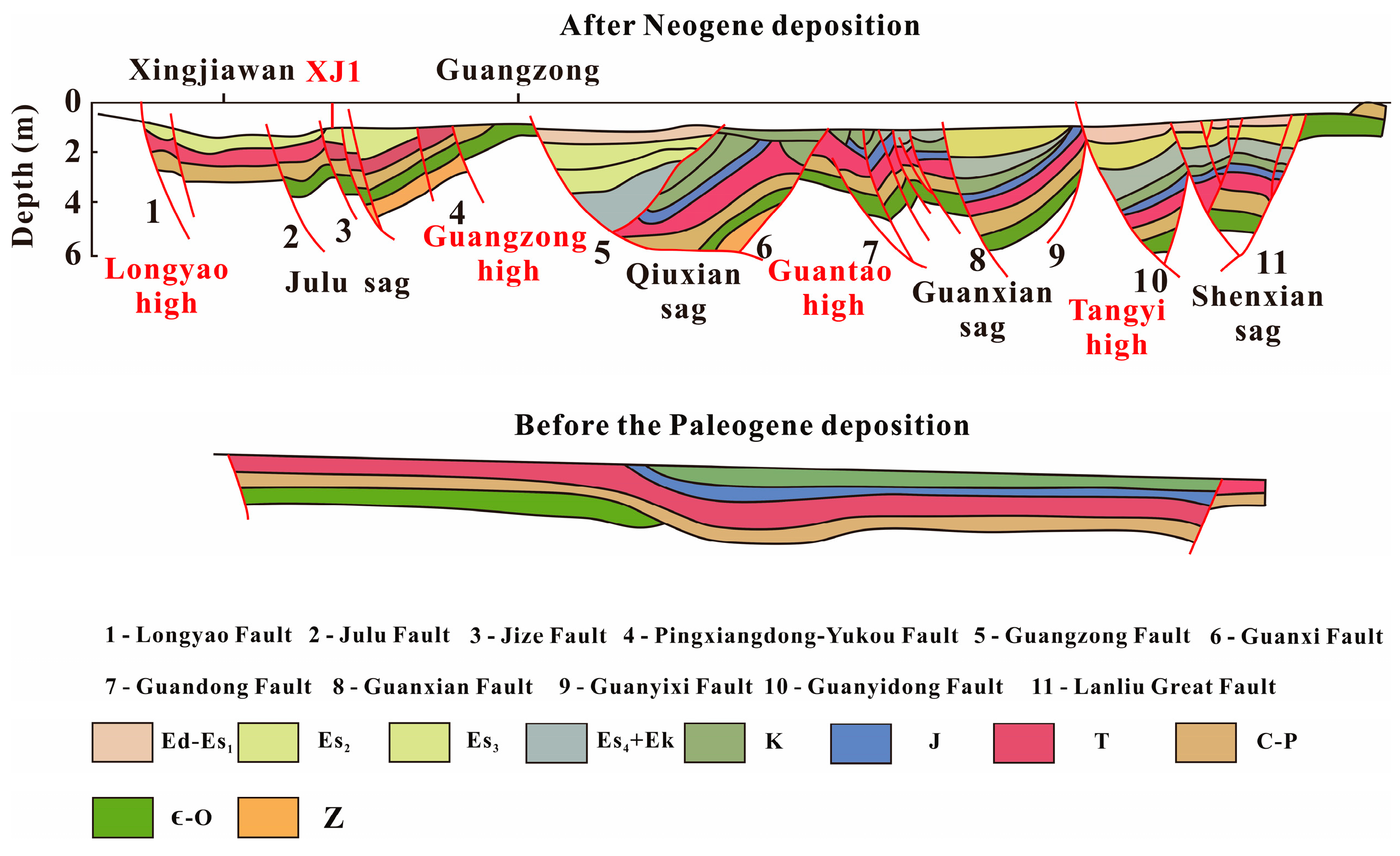


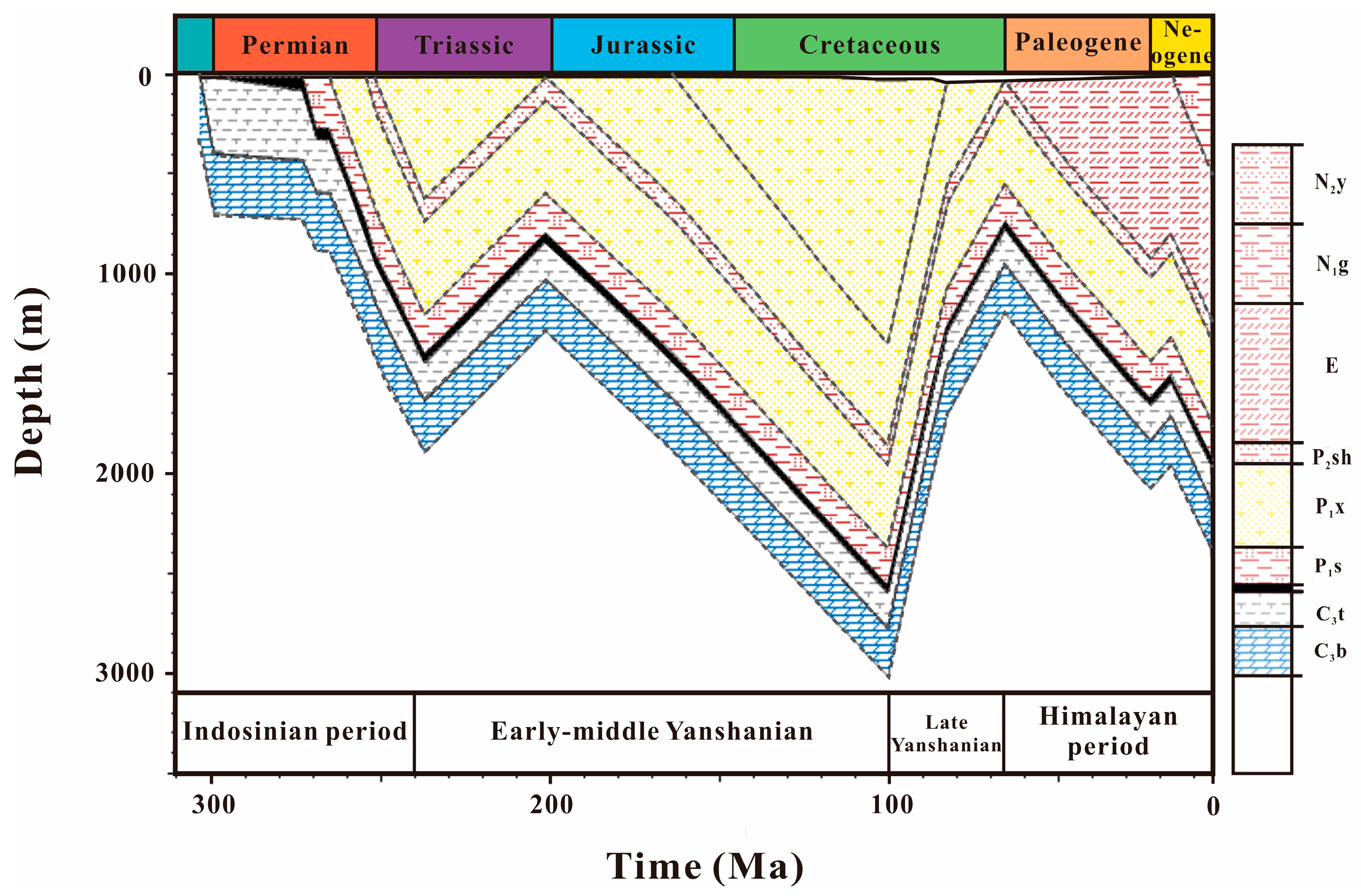
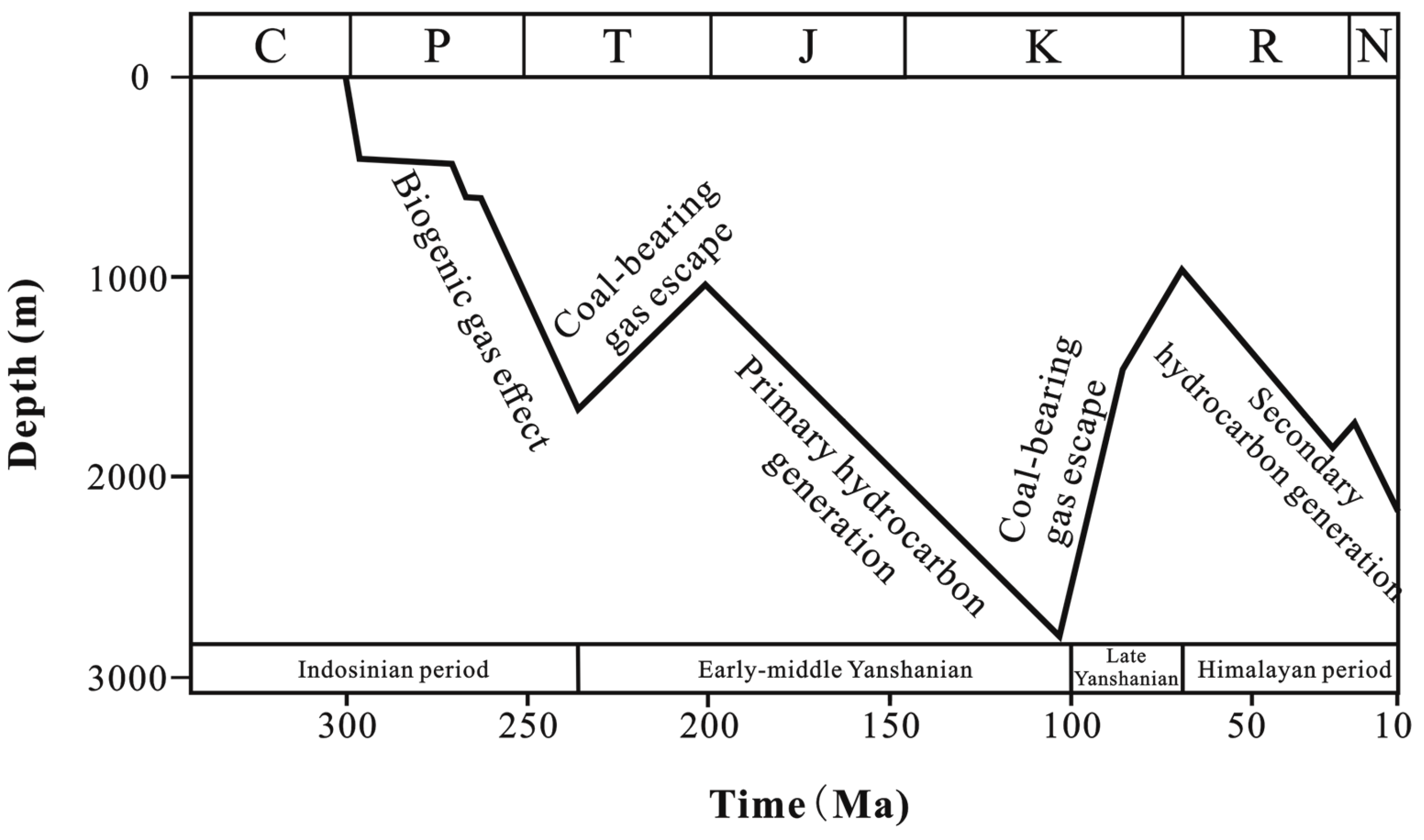

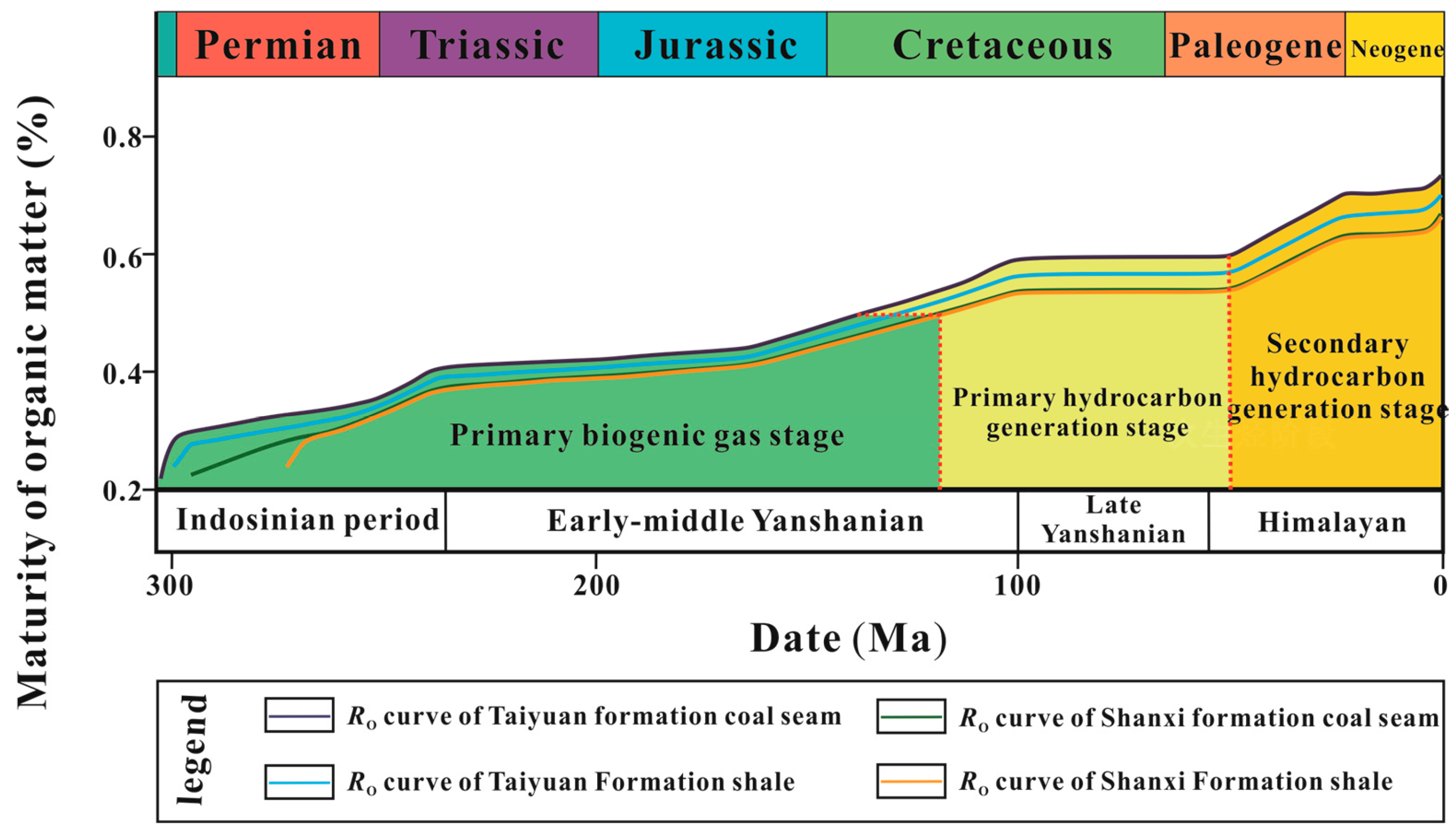
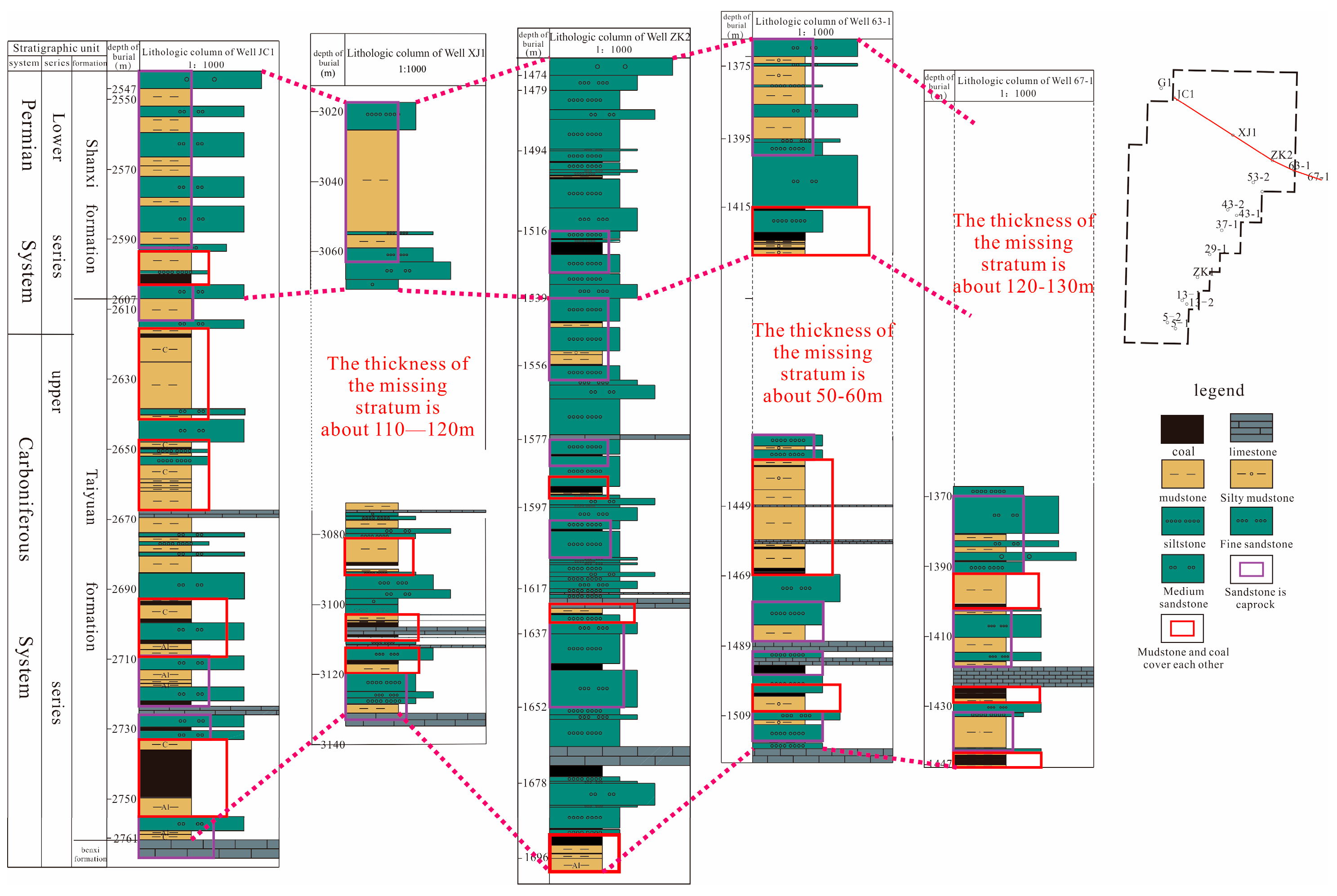
| Stratum | Sample No. | Depth (m) | TOC (%) | RO (%) | Vitrinite (%) | Inertinite (%) | Exinite (%) |
|---|---|---|---|---|---|---|---|
| Shanxi Formation | XJ1-183 | 3026.31 | 6.52 | — | — | — | — |
| XJ1-184 | 3028.36 | 0.87 | — | — | — | — | |
| XJ1-185 | 3030.17 | 1.07 | — | — | — | — | |
| XJ1-186 | 3032.82 | 1.29 | — | — | — | — | |
| XJ1-187 | 3034.64 | 2.84 | — | — | — | — | |
| XJ1-188 | 3036.52 | 6.62 | — | — | — | — | |
| XJ1-189 | 3038.39 | 2.15 | — | — | — | — | |
| XJ1-190 | 3040.24 | 1.19 | — | — | — | — | |
| XJ1-191 | 3042.24 | 17.74 | — | — | — | — | |
| XJ1-192 | 3044.56 | 14.88 | — | — | — | — | |
| XJ1-215 | 3046.18 | 2.57 | — | — | — | — | |
| XJ1-216 | 3048.56 | 1.79 | — | — | — | — | |
| XJ1-217 | 3050.37 | 2.57 | — | — | — | — | |
| XJ1-218 | 3052.42 | 3.52 | — | — | — | — | |
| XJ1-6 | 3055.49 | 1.33 | 0.75 | 28 | 11 | 6 | |
| XJ1-8 | 3056.21 | 1.77 | 0.57 | 23 | 13 | 2 | |
| XJ1-10 | 3057.56 | 0.81 | 0.61 | 21 | 16 | 2 | |
| Taiyuan Formation | XJ1-28 | 3069.85 | 1.52 | 0.59 | 39 | 13 | 4 |
| XJ1-30 | 3071.45 | 1.27 | 0.69 | 23 | 14 | 3 | |
| XJ1-37 | 3074.65 | 0.84 | 0.79 | 16 | 21 | 0 | |
| XJ1-39 | 3075.9 | 1.85 | 0.56 | 14 | 22 | 3 | |
| XJ1-47 | 3081.51 | 2.27 | 0.63 | 25 | 7 | 13 | |
| XJ1-177 | 3083.56 | 2.56 | 0.62 | 29 | 6 | 0 | |
| XJ1-178 | 3084.6 | 2.49 | 0.63 | 25 | 11 | 0 | |
| XJ1-58 | 3089.75 | 0.95 | 0.61 | 17 | 16 | 5 | |
| XJ1-66 | 3103.63 | 3.66 | 0.81 | 18 | 16 | 3 | |
| XJ1-69 | 3105.35 | 1.39 | 0.85 | 24 | 18 | 3 | |
| XJ1-76 | 3110.4 | 4.02 | 0.7 | 19 | 15 | 1 | |
| XJ1-82 | 3113.08 | 5.19 | 0.59 | 17 | 18 | 0 | |
| XJ1-153 | 3114.45 | 21.66 | 0.78 | 7 | 34 | 0 | |
| XJ1-93 | 3116.1 | 11.25 | 0.79 | 18 | 19 | 1 | |
| XJ1-98 | 3118.71 | 0.24 | 0.84 | 21 | 17 | 1 | |
| XJ1-101 | 3119.9 | 0.47 | 0.75 | 19 | 21 | 0 | |
| XJ1-171 | 3130.15 | 0.64 | 0.65 | 24 | 11 | 5 | |
| XJ1-172 | 3131.4 | 9.21 | 0.37 | 21 | 12 | 5 | |
| XJ1-M1 | 3088.50 | — | 0.67 | 53.2 | 35.3 | 8.7 | |
| XJ1-M2 | 3107.05 | — | 0.62 | 40.1 | 46.4 | 0.6 | |
| XJ1-M3 | 3109.85 | — | 0.59 | 70.1 | 17.6 | 6.0 | |
| XJ1-M4 | 3117.30 | — | 0.70 | 52.0 | 33.9 | 4.2 |
| Age (Ma) | Layer/Event | Depth (m) | Thickness (m) | Event Type | Paleodeposition /Erosion (m) | Lithology | PSE |
|---|---|---|---|---|---|---|---|
| 5.33 | N2Y | 829 | 398 | Deposition | Shale and Sandstone | Overburden | |
| 17 | N1g | 1227 | 403 | Deposition | Shale and Sandstone | Overburden | |
| 66 | E | 1630 | 701 | Erosion | 800 | Shale and Sandstone | Overburden |
| 163.5 | J3-K1 | 2331 | 0 | Erosion | −100 | Shale and Silt | Overburden |
| 201.3 | J1-J2 | 2331 | 0 | Erosion | −1100 | Sandstone | Overburden |
| 251.9 | T1-T2 | 2331 | 0 | Erosion | −400 | Sandstone | Overburden |
| 254.14 | P2sh | 2331 | 99 | Deposition | Sandstone | Overburden | |
| 265.1 | P1x | 2430 | 596 | Deposition | Shale and Sandstone | Reservoir | |
| 296 | P1s | 3026 | 37 | Deposition | Sandstone (Clay Rich) | Reservoir | |
| 299 | P1s2 | 3063 | 4 | Deposition | Coal | Source Rock | |
| 303 | C3t1 | 3067 | 6 | Deposition | Coal | Source Rock | |
| 303.5 | C3t2 | 3073 | 58 | Deposition | Shale (Organic Rich, 3% TOC) | Reservoir | |
| 307 | C3b | 3131 | 239 | Deposition | Dolomite (typical) | Reservoir |
| Coal (Rock) Layer Characteristics | Coal-Bearing Basin | ||||
|---|---|---|---|---|---|
| Southern Qinshui Basin | Julu Sag | ||||
| Coal seam | Series of strata | Shanxi Formation (No. 3 coal) | Taiyuan Formation (No. 15 coal) | Shanxi Formation (No. 2 coal) | Taiyuan Formation (No. 8 coal) |
| Buried depth (m) | 208.0–1150.0 | 208.0–1121.3 | 1300–3060 | 1580–3100 | |
| Thickness (m) | 0.50 (a)–11.2 (b) (6.0) (c) | 0.4 (a)–19.4 (b) (6.4) | 2.34 (a)–5.80 (b) (4.02) | 1.57 (a)–3.23 (b) (2.44) | |
| Porosity (%) | 0.63 (a)–10.59 (b) | 0.63 (a)–10.59 (b) | — | — | |
| Permeability (mD) | 0.004 (a)–13.010 (b) (1.570) (c) | 0.010 (a)–6.640 (b) (1.130) (c) | — | — | |
| Gas content (m3·t−1) | 3.7 (a)–27.4 (b) (13.8) (c) | 6.6 (a)–35.1 (b) (17.4) (c) | 0.25 (a)–1.93 (b) (0.733) (c) | 0.22 (a)–1.01 (b) (0.53) (c) | |
| Mudstone | Thickness (m) | 16.00 (a)–90.0 (b) (30.0) (c) | 10.0 (a)–60.0 (b) (35.0) (c) | 80 (a)–100 (b) (90) (c) | 20 (a)–50 (b) (30) (c) |
| Porosity (%) | 2.15 (a)–6.95 (b) (4.22) (c) | 2.35 (a)–5.46 (b) (4.28) (c) | 6.44 | 1.31 (a)–4.99 (b) (2.59) (c) | |
| Permeability (mD) | — | — | 0.00196 | 0.000278 (a)–0.0529 (b) (0.00863) (c) | |
| TOC (%) | 0.43 (a)–6.42 (b) (2.07) (c) | 0.36 (a)–3.94 (b) (1.89) (c) | 0.81 (a)–17.74 (b) (4.09) (c) | 0.24 (a)–21.66 (b) (3.97) (c) | |
| Hydrocarbon potential (mg·g−1) | 0.99 | 0.99 | 0.69 (a)–82.07 (b) (15.75) (c) | 0.46 (a)–130.44 (b) (22.19) (c) | |
| Composition of mineral | Clay mineral content is 50.0–63.0% with an average of 58.0% | Clay mineral content is 53.0–62.0% with an average of 56.6% | Clay mineral content is 26.6–56.0% with an average of 46.1%, followed by quartz, with content between 21.0 and 37.5% | Clay mineral content is 24.4–70.5% with an average of 44.5%, followed by quartz, with content between 23.4 and 64.5% | |
Disclaimer/Publisher’s Note: The statements, opinions and data contained in all publications are solely those of the individual author(s) and contributor(s) and not of MDPI and/or the editor(s). MDPI and/or the editor(s) disclaim responsibility for any injury to people or property resulting from any ideas, methods, instructions or products referred to in the content. |
© 2024 by the authors. Licensee MDPI, Basel, Switzerland. This article is an open access article distributed under the terms and conditions of the Creative Commons Attribution (CC BY) license (https://creativecommons.org/licenses/by/4.0/).
Share and Cite
Wang, Y.; Zhang, H.; Yang, L.; Zhu, Y.; Chang, Z. Geochemical Characteristics and Hydrocarbon Generation Potential of Coal-Measure Source Rocks in Julu Sag. Processes 2024, 12, 1399. https://doi.org/10.3390/pr12071399
Wang Y, Zhang H, Yang L, Zhu Y, Chang Z. Geochemical Characteristics and Hydrocarbon Generation Potential of Coal-Measure Source Rocks in Julu Sag. Processes. 2024; 12(7):1399. https://doi.org/10.3390/pr12071399
Chicago/Turabian StyleWang, Yang, Hanyu Zhang, Liu Yang, Yanming Zhu, and Zhixiang Chang. 2024. "Geochemical Characteristics and Hydrocarbon Generation Potential of Coal-Measure Source Rocks in Julu Sag" Processes 12, no. 7: 1399. https://doi.org/10.3390/pr12071399




